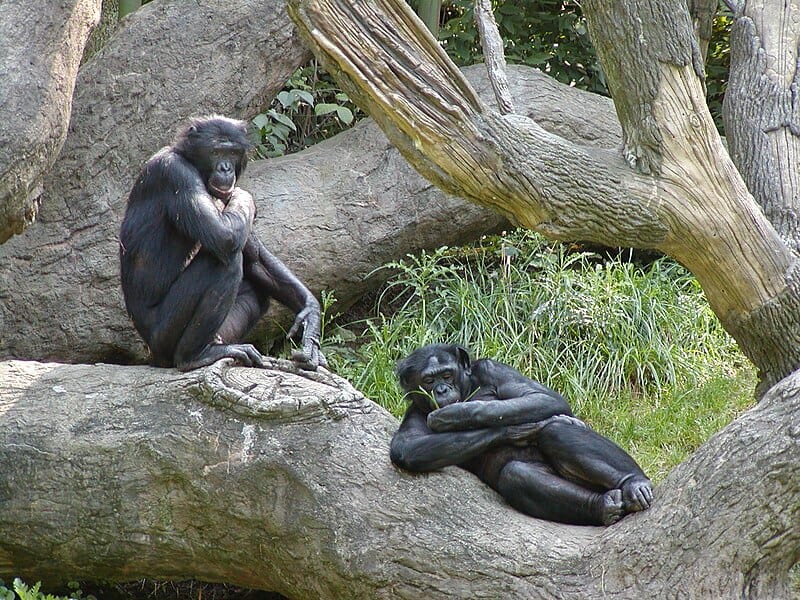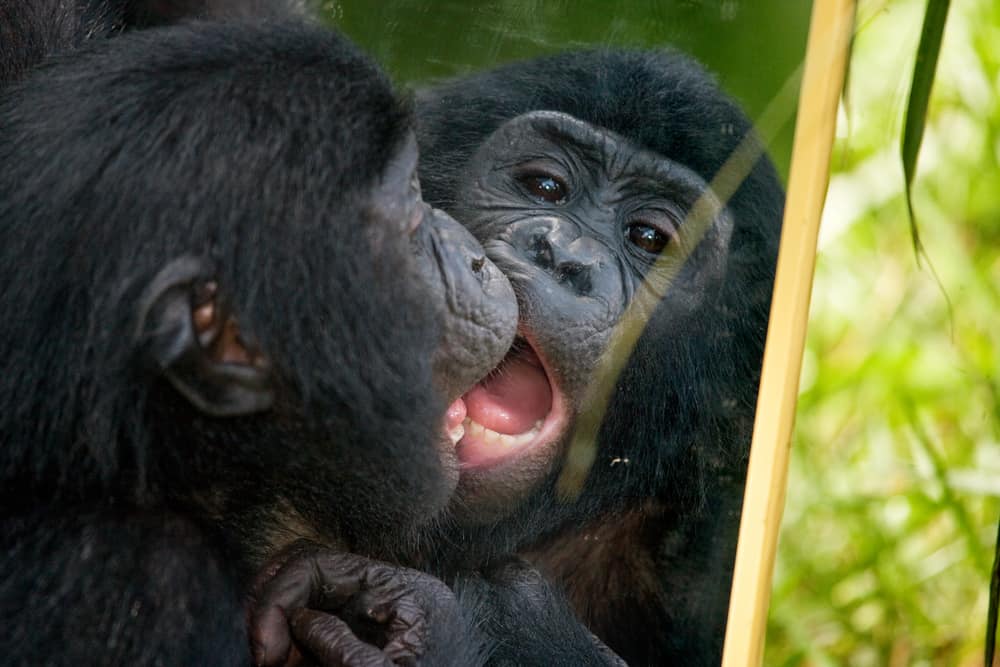In the dense rainforests of the Democratic Republic of Congo, a remarkable species of great ape challenges our fundamental understanding of cooperation, social structures, and evolutionary biology. Bonobos (Pan paniscus), often called “the forgotten ape,” have remained in the shadow of their more famous cousins, chimpanzees, yet their unique social behaviors offer profound insights into the evolution of cooperation and conflict resolution. Unlike most primate societies structured around male dominance and competition, bonobos have developed a female-dominated society where cooperation, sharing, and non-violent conflict resolution are the norm. This article explores how bonobos are revolutionizing our understanding of cooperation in nature and what this might reveal about our species’ evolutionary path.
The Discovery and Recognition of Bonobos

Bonobos were not recognized as a distinct species from chimpanzees until 1929, making them the last great ape to be cataloged by Western science. Initially classified as “pygmy chimpanzees,” a term now considered inaccurate, these apes remained scientifically understudied for decades. It wasn’t until the pioneering work of researchers like Takayoshi Kano in the 1970s that the scientific community began to appreciate bonobos’ unique social structure and behavior. Their late discovery and the political instability in their native Congo have contributed to bonobos receiving significantly less research attention than other great apes, despite their critical importance to understanding the spectrum of primate social organization and the evolution of human sociality.

Perhaps the most striking aspect of bonobo society is its female-dominated social structure—a rarity in the primate world and especially among great apes. Unlike the male-dominated hierarchies of chimpanzees, gorillas, and orangutans, bonobo females form strong coalitions that collectively dominate males, despite males’ greater individual physical strength. This female dominance is maintained through strong social bonds between unrelated females—a pattern that contrasts with most primate societies where males typically remain in their birth group while females disperse. Researchers believe this unusual social arrangement may have evolved due to the relatively abundant food resources in bonobos’ habitat, reducing male-male competition for food and enabling female coalitions to emerge as the primary social force. This female-centered society creates a foundation for the unique cooperative behaviors that set bonobos apart.
The Role of Sexual Behavior in Maintaining Peace

Bonobos are perhaps most famous for their frequent and diverse sexual interactions, which serve crucial social functions beyond reproduction. Unlike most other animals, bonobos engage in sexual behaviors across all age and sex combinations, using these interactions to reduce tension, reconcile after conflicts, and strengthen social bonds. Sexual contact occurs between males and females, females and females, and males and males, with female-female sexual contact (genito-genital rubbing or “GG-rubbing”) being particularly important for alliance formation. This sexual behavior effectively substitutes for the aggression and violence seen in chimpanzee societies, functioning as a mechanism for conflict resolution and social cohesion. The bonobo’s use of sexual behavior as a social tool demonstrates a sophisticated understanding of relationship management and represents a unique evolutionary solution to the challenges of social living.
Food Sharing and Cooperative Foraging

Bonobos exhibit exceptional levels of food sharing compared to other great apes, with multiple studies documenting voluntary food sharing even between unrelated individuals. In experimental settings, bonobos will often unlock doors to allow others access to food resources, even when there is no immediate benefit to themselves. In the wild, they frequently share highly valued food items like meat and large fruits. This sharing often occurs in complex social contexts—for example, females may share with males in exchange for coalition support or with other females to strengthen alliances. Research by primatologists such as Brian Hare and Vanessa Woods has demonstrated that bonobos outperform chimpanzees in cooperative tasks where food must be shared, suggesting a deeper predisposition toward cooperation. This extensive food sharing network contributes significantly to the relatively egalitarian resource distribution in bonobo society.
Empathy and Prosocial Behavior

Emerging research suggests that bonobos possess highly developed empathetic abilities that may underpin their cooperative society. Studies show they spontaneously help both familiar and unfamiliar bonobos without expectation of reward—a level of prosocial behavior rarely documented in other non-human primates. In laboratory experiments, bonobos have demonstrated “contagious yawning” (a marker of empathy) and will comfort distressed individuals through embracing, grooming, and sexual contact. Perhaps most tellingly, they appear sensitive to others’ emotional states and will intervene to reduce others’ distress even at personal cost. This capacity for empathy extends beyond their own species; bonobos have been observed adopting orphaned wild animals and sharing food with them. These empathetic tendencies provide a psychological foundation for the remarkably cooperative nature of bonobo society.
Conflict Resolution Without Violence

While aggression exists in bonobo society, their approach to conflict resolution stands in stark contrast to chimpanzees and many other primates. Lethal aggression between bonobos has never been observed in the wild, and severe injuries from conflicts are extremely rare. Instead, bonobos employ an array of non-violent strategies to resolve tensions, including sexual contact, grooming, play, and food sharing. When conflicts do arise, they are typically resolved quickly through reconciliation behaviors, often initiated by females. This peaceful approach to conflict resolution has been linked to elevated levels of oxytocin (often called the “bonding hormone”) in bonobos compared to chimpanzees. Their society demonstrates that effective cooperation doesn’t require the threat of punishment that characterizes many human cooperative systems, offering an alternative evolutionary pathway to a functional social group.
The Bonobo Brain: Wired for Cooperation

Recent neuroanatomical research reveals that the bonobo brain has specialized neural pathways that may facilitate their cooperative tendencies. Compared to chimpanzees, bonobos have more developed brain regions associated with empathy, impulse control, and social awareness. They show greater activation in the anterior cingulate cortex, insula, and amygdala—areas associated with emotional processing and social bonding—when viewing scenes of other bonobos in distress. Additionally, bonobos have more abundant connections between the brain’s emotional centers and prefrontal cortex, potentially enabling better regulation of aggressive impulses. These neurological differences may reflect evolutionary adaptations supporting their unique social system and suggest that the capacity for cooperation is literally “hardwired” into bonobo biology, challenging simplistic notions that aggression and competition are the default modes in primate societies.
Cooperation with Strangers: Defying Territorial Logic

Perhaps one of the most surprising aspects of bonobo behavior is their willingness to cooperate with strangers and members of other groups. While most primates—including chimpanzees—react with hostility to unfamiliar individuals, bonobos often engage in peaceful interactions with members of neighboring communities. Field researchers have documented neighboring bonobo groups sharing feeding sites without aggression and even engaging in social grooming and sexual interactions across group lines. In captive settings, bonobos readily cooperate with strangers in experimental tasks, showing little of the in-group preference that characterizes most primate cooperation. This openness to “foreign” individuals challenges conventional evolutionary theories that predict strict territoriality and xenophobia, suggesting that cooperation can evolve beyond the boundaries of genetic relatedness or established group membership under certain ecological conditions.
Evolutionary Implications: The Self-Domestication Hypothesis

The cooperative nature of bonobos has led some researchers to propose that they represent a case of “self-domestication”—an evolutionary process similar to what transformed wolves into dogs, but occurring naturally without human intervention. According to this hypothesis, bonobos evolved from a chimpanzee-like ancestor but underwent selection against aggression, resulting in a suite of physical and behavioral changes similar to those seen in domesticated animals. These include reduced sexual dimorphism (size difference between males and females), more juvenile facial features, reduced tooth size, and decreased testosterone levels compared to chimpanzees. Proponents of this hypothesis, including anthropologist Richard Wrangham, suggest that the abundance of food in the bonobo habitat south of the Congo River reduced competition, allowing selection to favor less aggressive individuals who could better maintain cooperative social bonds. If correct, this hypothesis offers a natural experiment in how cooperation can evolve from a more competitive ancestral state.
The Endangered Status of Bonobo Cooperation

The remarkable cooperative society of bonobos exists under severe threat. With fewer than 20,000 individuals remaining in the wild, bonobos are endangered and face multiple conservation challenges. Civil unrest in the Democratic Republic of Congo has disrupted research and conservation efforts, while habitat destruction, bushmeat hunting, and the illegal pet trade continue to reduce their numbers. The loss of bonobos would not only represent the extinction of one of our closest living relatives but would also eliminate a unique evolutionary experiment in cooperation. Each bonobo community lost potentially erases distinctive cultural traditions and cooperative solutions that have evolved in that particular group. Conservation efforts by organizations like the Bonobo Conservation Initiative focus not just on protecting the apes but also on working cooperatively with local communities to create sustainable conservation models, demonstrating that human-bonobo cooperation may hold the key to their survival.
Challenging the “Killer Ape” Narrative

The cooperative nature of bonobo society directly challenges longstanding narratives about human evolution that emphasize violence, male dominance, and competition as the driving forces behind our species’ success. For decades, the “killer ape” theory popularized by writer Robert Ardrey and others suggested that aggression and warfare were inevitable outgrowths of our primate heritage. Chimpanzees, with their territorial patrols and occasional lethal raids on neighboring groups, seemed to support this view. Bonobos, however, demonstrate that our closest living relatives include both a more aggressive species (chimpanzees) and a more peaceful one (bonobos). This realization forces a reconsideration of human evolutionary psychology, suggesting that our capacity for cooperation, empathy, and peaceful conflict resolution may be just as deeply rooted in our evolutionary past as our capacity for violence. Bonobos remind us that nature offers multiple evolutionary pathways, not a single template for social organization.
What Bonobos Teach Us About Human Cooperation

The study of bonobo cooperation offers valuable insights for understanding human social behavior. While humans have developed complex cultural institutions to facilitate cooperation among strangers—including laws, markets, religions, and social norms—bonobos achieve similar outcomes through biological and social adaptations. Their society suggests that cooperation can evolve as a primary strategy rather than as a secondary response to competition. Human societies show extraordinary variation in cooperative tendencies across cultures, from highly competitive to deeply communal structures, suggesting that we may share with bonobos a flexibility in social organization that responds to ecological and social contexts. Most importantly, bonobos demonstrate that female empowerment and reduced sexual dimorphism can create social conditions conducive to cooperation and peace—a lesson that may have profound implications for human social policy and gender equality initiatives.
Conclusion: Redefining Our Understanding of Natural Cooperation

Bonobos stand as nature’s most compelling challenge to traditional views of competition and cooperation in evolutionary biology. Their female-dominated, sexually egalitarian, and strikingly peaceful society demonstrates that nature can produce cooperative systems that don’t rely on dominance, punishment, or kinship to function effectively. As we face global challenges requiring unprecedented levels of human cooperation—from climate change to pandemic response—the lessons from bonobo society become increasingly relevant. They remind us that our evolutionary heritage includes profound capacities for both competition and cooperation, aggression and empathy. In protecting bonobos from extinction, we preserve not only a fascinating biological relative but also a living laboratory of cooperation that continues to expand our understanding of what is possible in primate societies. The bonobo way suggests that cooperation is not merely a thin veneer over competitive self-interest but can form the foundational structure of a successful social species.
Writer at Animals Around The Globe
Esther is from India; the heartbeat of South Asia, holding a Master’s degree in Zoology and a postgraduate diploma in Animal Welfare. Her enthusiasm for animal welfare drives her passion and dedication to work for animals, ensuring their well-being and advocating for their rights. With a solid academic background and hands-on experience, she is committed to making a positive impact in the field of animal welfare.In her free time, she enjoys embroidery and sewing. As a Chennaite from Tamil Nadu, Esther loves Bharathanatyam, an Indian classical dance form.